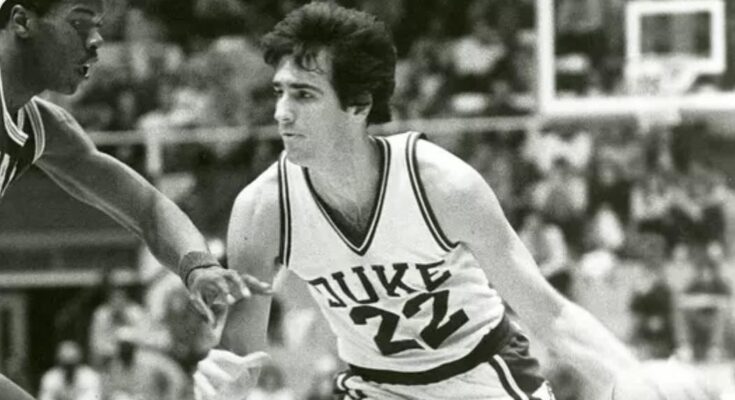**“Remembering Tom Emma: Manhasset Legend Who Broke Jim Brown’s Record, Starred at Duke, and Left a Lasting Legacy Before His Passing in 2011”**
Tom Emma’s story is one that resonates far beyond the basketball court, a journey of talent, discipline, leadership, and legacy that intertwined with the rich histories of both Manhasset High School and Duke University. His path to recognition began in Manhasset, a Long Island town with a strong tradition of high school athletics, where he quickly established himself as one of the most dominant players of his era. What made Emma’s high school career so remarkable was not only his statistical accomplishments but also the way he elevated his team and community. The defining moment of his prep career came when he broke Jim Brown’s school scoring record, a mark held by one of the most legendary athletes in American sports history. Brown was not only a dominant high school player but went on to become a Hall of Fame running back in the NFL and a cultural icon, so for Emma to eclipse a record that bore his name placed him immediately into elite company. By the time Emma’s senior season concluded in 1978, he had been selected as an All-Long Island player, cementing himself as one of the premier talents in the region and putting him on the radar of major college programs.
When he chose Duke University, Emma entered a program that was beginning to carve out its place in the upper echelon of college basketball. The late 1970s and early 1980s were transformative years for Duke basketball, years that laid the groundwork for the eventual dynasty the Blue Devils would become. Emma’s role in those formative seasons was an important one, as he became a reliable contributor across 110 career games. Playing that many contests in an era when the college game was different—slower-paced, more physical, and with fewer possessions—was a testament to his durability and consistency. Coaches valued Emma not only for his scoring and ball-handling but especially for his ability to make the most of every opportunity at the free throw line. To this day, his name remains etched into Duke’s record books, as he ranks fourth all-time in program history for free throw percentage. That achievement might sound like a niche statistic, but in reality, it speaks volumes about Emma’s discipline and reliability. Free throws are often referred to as the easiest shot in basketball, but in truth they are among the hardest when pressure mounts. A player who consistently steps to the line and converts in big moments earns the trust of teammates and coaches alike, and Emma’s proficiency at the line is one of the reasons his legacy at Duke remains secure.
But numbers alone only tell part of his story. Those who knew him often spoke about his dedication, his intensity, and his ability to inspire those around him. At Manhasset, Emma was remembered as a leader, the kind of player who worked relentlessly in practice and expected the same from others. That same mindset carried over to Duke, where, even if he wasn’t the flashiest player on the floor, he became a dependable presence who could be counted on night in and night out. Emma’s career bridged an important era for Duke basketball, one that included battles in the rugged ACC and games against programs that defined college basketball at the time, such as North Carolina, Maryland, and Virginia. Playing in that environment required not only skill but also a mental toughness, something Emma had in abundance.
After college, Emma’s path remained closely connected to the game of basketball, though in different ways than many of his peers. He built a reputation not just as a former player but also as an author, motivator, and individual who sought to share lessons about health, fitness, and the athlete’s mindset. His commitment to personal development reflected the same kind of focus that had made him a standout on the court. He understood that athletics were not only about competition but also about building a foundation for lifelong growth, discipline, and resilience. His life after Duke was marked by a continued engagement with the sports world, whether through writing or through his personal work with others.
Tragically, Tom Emma’s story came to an early end when he passed away in 2011. His death shocked those who knew him and the larger basketball community, as he was only 49 years old. For those who had watched him grow from a high school phenom at Manhasset into a respected figure at Duke, and later into an author and mentor, the news was heartbreaking. Yet, while his life was cut short, his legacy endures in multiple ways. At Manhasset, he will forever be remembered as the player who surpassed Jim Brown’s legendary mark, a symbol of how dedication and talent can lead to extraordinary achievements. At Duke, his name in the record books stands as a testament to his accuracy, poise, and the value of precision in moments that decide games. And beyond the box scores and stat sheets, he is remembered by teammates, friends, and family as someone who cared deeply about others and poured himself fully into every endeavor.
Reflecting on his career, one can see how Emma’s story connects past and present. Jim Brown, whose record he broke, was not only a sports icon but also a figure who represented dominance and excellence across multiple fields. For Emma to surpass him in scoring at Manhasset was symbolic of how each generation builds upon the accomplishments of the last, carrying forward the legacy of athletic greatness in new ways. Similarly, Emma’s time at Duke links him to one of the most storied programs in college basketball history, a program that would later produce some of the greatest players and teams the sport has ever seen. His contributions, while perhaps not as heralded as some of Duke’s later stars, are nonetheless woven into the fabric of that tradition.
Another important aspect of Emma’s legacy is how it illustrates the power of sports to create enduring connections. High school teammates, college teammates, coaches, and fans all carry memories of his performances and his presence. Even decades later, his name evokes respect and admiration. The fact that his free throw percentage remains one of the best in Duke history shows not only his talent but also his attention to detail—qualities that resonate with anyone who understands what it takes to succeed in competitive environments. His story serves as an inspiration to young athletes who may not be the tallest or fastest but who recognize that precision, practice, and mental toughness can separate them from the rest.
Emma’s life also highlights the importance of balance. While his accomplishments in athletics were significant, his decision to write and share knowledge about health and fitness demonstrates that he saw value in contributing beyond the court. He understood that his platform could be used to help others improve themselves, and in doing so, he extended his influence beyond wins and losses. This dimension of his career reveals a man who was not defined solely by what he did with a basketball but also by how he used the lessons of sport to enrich his life and the lives of others.
The news of his passing in 2011 serves as a reminder of the fragility of life, but also of the enduring nature of legacy. While he is no longer here, the records he set, the games he played, and the lives he touched ensure that his name lives on. For Manhasset, his story is an integral part of the school’s proud athletic history, linking the present to the era when legends like Jim Brown walked its halls. For Duke, his career is part of the larger story of a program that has come to symbolize excellence in college basketball. And for those who knew him personally, his memory is kept alive through stories, reflections, and the impact he had as a teammate, friend, and mentor.
In remembering Tom Emma, one is reminded of the many ways sports shape identity and community. His journey from Manhasset to Duke, from breaking records to making his mark in the record books, and from athlete to mentor encapsulates the richness of a life dedicated to growth, achievement, and contribution. Though his passing was a tragic loss, the story of his accomplishments ensures that his legacy continues to inspire future generations. His ability to surpass legends, his place in the storied history of Duke basketball, and his commitment to excellence in every aspect of life all combine to make his story one worth telling and retelling. Tom Emma was more than a basketball player—he was a symbol of perseverance, precision, and passion, and his life remains a testament to what can be achieved when talent meets dedication.



